Fall Chores in the Pollinator Garden: Leave the Leaves and Save the Stems!
go.ncsu.edu/readext?990679
en Español / em Português
El inglés es el idioma de control de esta página. En la medida en que haya algún conflicto entre la traducción al inglés y la traducción, el inglés prevalece.
Al hacer clic en el enlace de traducción se activa un servicio de traducción gratuito para convertir la página al español. Al igual que con cualquier traducción por Internet, la conversión no es sensible al contexto y puede que no traduzca el texto en su significado original. NC State Extension no garantiza la exactitud del texto traducido. Por favor, tenga en cuenta que algunas aplicaciones y/o servicios pueden no funcionar como se espera cuando se traducen.
Português
Inglês é o idioma de controle desta página. Na medida que haja algum conflito entre o texto original em Inglês e a tradução, o Inglês prevalece.
Ao clicar no link de tradução, um serviço gratuito de tradução será ativado para converter a página para o Português. Como em qualquer tradução pela internet, a conversão não é sensivel ao contexto e pode não ocorrer a tradução para o significado orginal. O serviço de Extensão da Carolina do Norte (NC State Extension) não garante a exatidão do texto traduzido. Por favor, observe que algumas funções ou serviços podem não funcionar como esperado após a tradução.
English
English is the controlling language of this page. To the extent there is any conflict between the English text and the translation, English controls.
Clicking on the translation link activates a free translation service to convert the page to Spanish. As with any Internet translation, the conversion is not context-sensitive and may not translate the text to its original meaning. NC State Extension does not guarantee the accuracy of the translated text. Please note that some applications and/or services may not function as expected when translated.
Collapse ▲After planting, weeding, and watering through the spring and summer, some gardeners look forward to fall as a period of rest as plants senesce at the end of the season. Other gardeners are eager to continue with chores through the end of the year. There are still plenty of things that can/need to be done in the fall, but the good news is there are also tasks you can delay until late winter or early spring (while also benefitting wildlife!).
We have been busy with fall chores in Cooperative Extension’s Pollinator Paradise Demonstration Garden since October. The demonstration garden has over 225 unique species, 85% of them native to North Carolina. It serves as an outreach tool to teach about planting and maintaining pollinator habitat and I conduct dozens of tours each year for folks from across the state. A wonderful and dedicated group of volunteers helps me maintain the garden. I get lots of questions about maintenance so I hope you find this article helpful. A well planned and wisely maintained pollinator garden is beautiful and beneficial year-round.
All of the photos in this article were taken in the Pollinator Paradise Garden. Each photo has a descriptive caption.

Fall color in the pollinator garden with native shrubs, perennials, vines, and grasses. We had about 40 species still in bloom in November! Photo by Debbie Roos.

The goal of a pollinator garden is to provide as long of a season of bloom as possible through a diversity of species. It’s not unusual to have one species that has finished blooming and gone to seed next to another species in peak bloom. This late blooming aromatic aster provides a nice contrast to the intricate seedheads of mountain mint in the foreground. Photo by Debbie Roos.
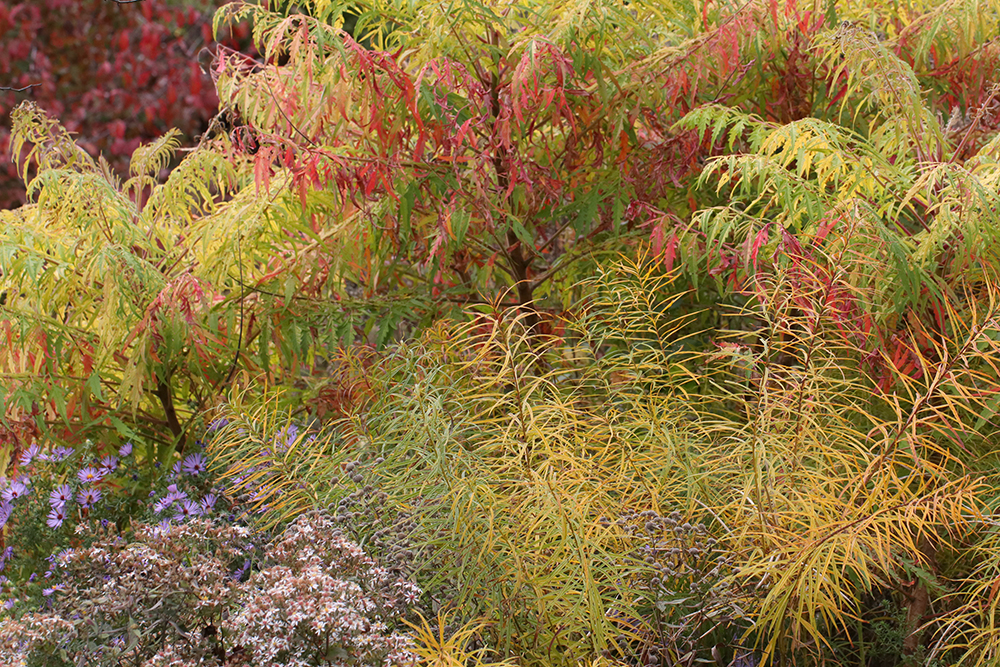
Fall color provided by both foliage and blooms! Blackhaw viburnum, staghorn sumac, bluestar, white wood aster, and aromatic aster. Photo by Debbie Roos.
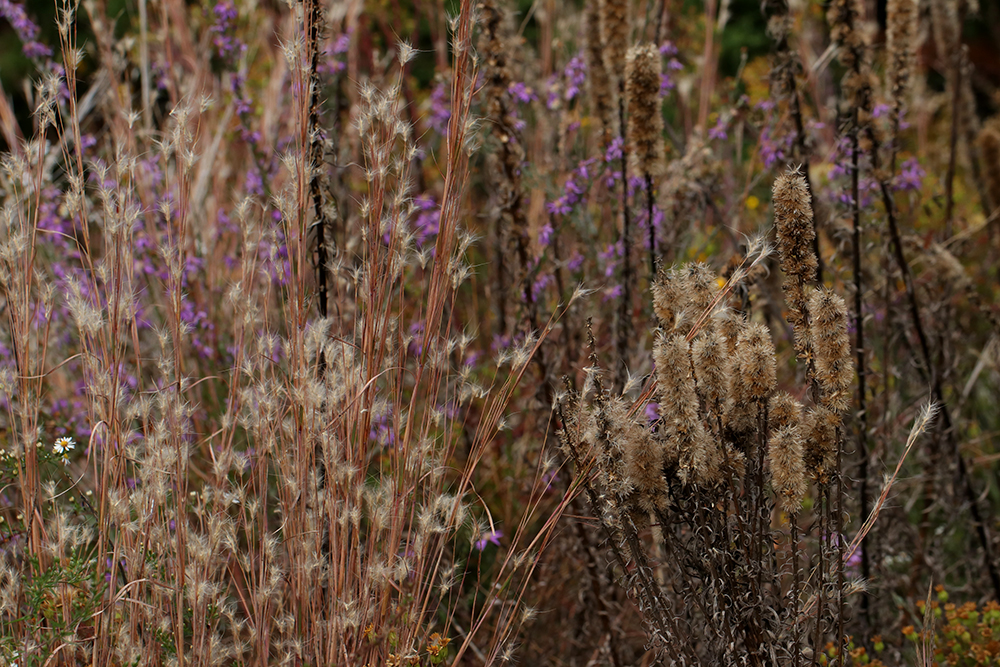
Flowering splitbeard bluestem grass with eastern silvery aster and seedheads of blazing star. Photo by Debbie Roos.
Even though I frame the following discussion as things “to do” and “not do” in the garden, my goal here is to educate folks about the role of habitat features and how maintenance and timing can impact wildlife. I understand that we each have our own unique goals and preferences and I trust that readers will use this information to make decisions that work best for them, their garden, and wildlife!
Things TO DO in the Fall in the Pollinator Garden
Divide and Plant
Fall is a great time to thin out any plants that have spread where you don’t want them to. This fall in the pollinator garden we have divided aggressive species such as clasping aster, cup plant, spotted horsemint, bluestar, green-head coneflower, frost aster, ironweed, splitbeard bluestem, and others and shared them with volunteers or replanted elsewhere in the garden.

Cup plant seedlings that have spread in the garden. Cup plant will aggressively seed in and outcompete other plants so wayward seedlings are removed in the fall to maintain species diversity. Photo by Debbie Roos.
Fall is the optimal time for planting perennials because the soil is still warm enough that roots can start getting established and get a head start for the following spring. Even in my “completed” pollinator garden we wind up planting every fall. Sometimes we are expanding into a new area, and other times we are “editing” an existing bed. I don’t necessarily go by the calendar when timing the planting dates but wait until the temperatures have consistently cooled a bit and we are not in the middle of a drought. Usually the best months for planting are October and November in the North Carolina piedmont, but we have planted into December in some years. We also flag or tag any species we plant in the fall that have gone dormant and have nothing visible above ground (this reminds me what to water if rain is scarce at the end of the year).
Speaking of watering, don’t forget to irrigate new plantings each week or as needed (if it’s not raining) until plants go dormant in the winter. I make sure new plantings get a deep watering once a week (whether through rainfall or irrigation) for their first year (except during winter). This ensures they develop a good root system and become well established. I generally provide no supplemental irrigation after the first year.

Fall planted dormant Liatris plants are temporarily flagged for visibility. This species of Liatris is very short and was planted between the three established stoke’s asters. Photo by Debbie Roos.
Late fall is also a great time to direct seed native species so that they are subjected to cold, moist conditions in the winter to break seed dormancy. My pollinator garden was created from potted stock from local nurseries, but I have successfully seeded species like native field thistle and columbine throughout the beds (and I’m trying late figwort and fernleaf phacelia this year!).

Bumble bee foraging on native field thistle. This species is direct-seeded in the fall. Seeds go through cold stratification during the winter and germinate in the spring. It bloomed in its second year and quickly became a pollinator magnet. Photo by Debbie Roos.
Weed
Weeding can be done pretty much year-round in the pollinator garden. In the fall both warm-season weeds like bermudagrass, oxalis, trumpet vine, and others need weeding along with cool-season weeds like creeping charlie and chickweed. It’s a good idea to stay on top of chickweed throughout the fall and winter or it will overwhelm emerging perennials in the spring!
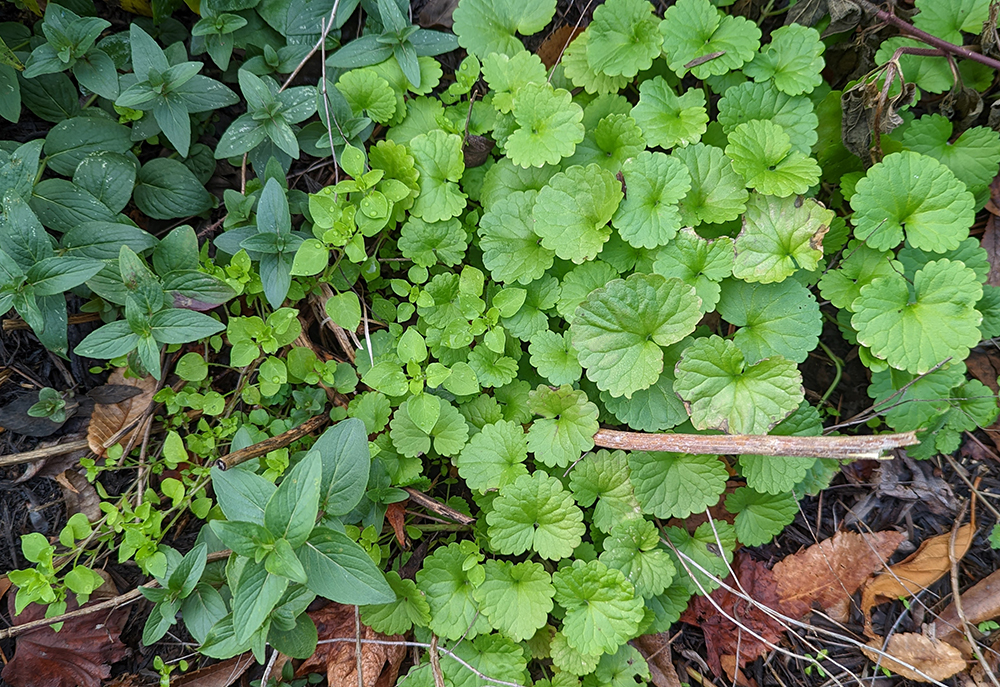
Mountain mint surrounded by chickweed and creeping charlie. Photo by Debbie Roos.
Tag Plants That Disappear in the Winter
Some perennials disappear in the winter (e.g., wild indigo and butterfly weed), leaving no leaves or stems to mark their spot in the garden. Wild indigo (Baptisia spp.) is notorious for this…it usually cuts itself off at the soil line in the fall, and before long it rolls away like a tumbleweed! I like to mark all of my Baptisias with a metal tag so that I don’t accidentally plant on top of them if I do any spring planting before they have emerged (this has happened several times!).

Metal tag marking where wild indigo is planted. Wild indigo cuts itself off at the soil line in the fall and blows away so it’s helpful to mark its spot to avoid planting on top of it. This one has already cut itself off and is just laying on top of the ground (it blew away like a tumbleweed a week after I took this photo). I like the metal tags because they are unobtrusive and blend in with the garden. Photo by Debbie Roos.
Things TO NOT DO in the Fall in the Pollinator Garden
Flowers provide food for pollinators through their pollen and nectar, but just as humans need more than food to survive, so do pollinators. That’s why it’s important to think beyond flowers when developing pollinator habitat. Pollinators and other critters also require shelter and nesting sites throughout their life. Planting flowers for pollinators and other wildlife is an important first step, but how you maintain your garden after planting has an impact on the benefits it provides.
Plant stems, leaf litter, brush piles, dead wood, and bare ground all provide critical habitat for insects and other wildlife throughout the year. Conserving and/or creating these habitat features can have a positive impact on the populations of native bees and other wildlife.
Since leaf litter and plant stems provide vital habitat, wildlife will benefit if you can retain most of these through the fall and winter.
Don’t Remove Leaves from Garden Beds: Leave the Leaves!
Fallen leaves provide vital ecosystem services, which is why it always confounds me to see how hard people work to get rid of them. A layer of fallen leaves provides shelter for insects and other invertebrates; the insects, berries, and nuts found in the leaf layer are an important food source for birds, mammals, turtles, and other critters; the leaves decompose, increase organic matter, and release nutrients back to trees and other plants; and they help reduce soil erosion, suppress weeds, and improve moisture retention.

Layer of leaves in the pollinator garden. Photo by Debbie Roos.
Most pollinators and other invertebrates spend the winter very near their spring and summer foraging sites in the landscape, just hidden from view, often amongst the fallen leaves.

Lady beetle on dried foliage of bluestar in the fall. Lady beetles are beneficial predators and overwinter in the garden in various stages, depending on the species. Some overwinter as adults and some overwinter as larvae or pupae in the leaves or in crevices. Photo by Debbie Roos.
Newly mated bumble bee queens hibernate through the winter, often just below the soil surface where a layer of leaves provides protection from the winter elements.
North Carolina has approximately 175 species of butterflies and over 2,700 species of moths. Except for the migratory butterflies (e.g., monarch, painted lady) our butterflies overwinter as adults, eggs, caterpillars, or chrysalids and they rely on the protection of a leaf layer to help them through the winter.
Swallowtails, clouded sulphurs, orange sulphurs, and spring azures overwinter in the chrysalis stage, well camouflaged among the leaf litter.
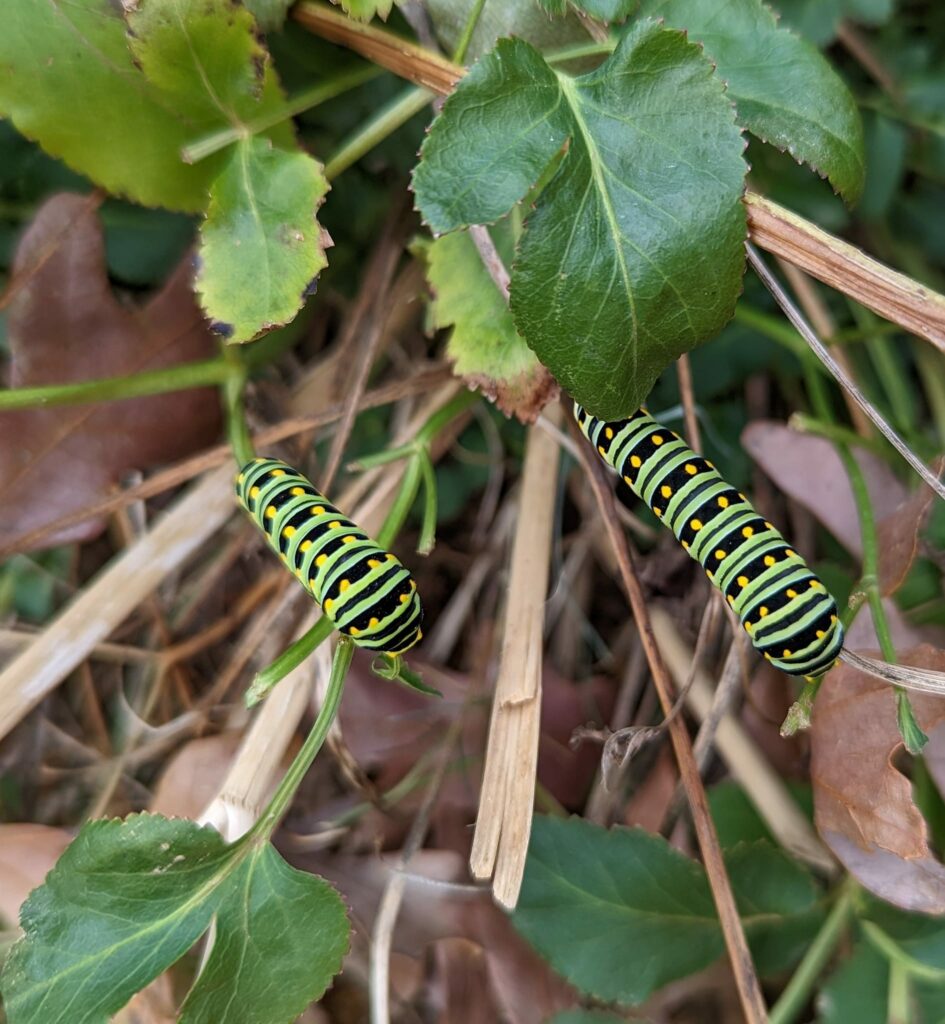
Late November black swallowtail caterpillars on their native host plant, golden alexander. Swallowtails overwinter in the chrysalis stage among the leaves. Photo by Debbie Roos.

Black swallowtail chrysalis on coneflower stem. Photo by Debbie Roos.
Some of our butterfly species overwinter as caterpillars. Examples include eastern tailed blue, great spangled fritillary, silvery checkerspot, northern crescent, red spotted purple, little wood satyr, and common wood-nymph. Leaves provide protection from the winter weather for these caterpillars.
Other species of butterflies like the red-banded hairstreak, coral hairstreak, and Edwards’ hairstreak overwinter in the egg stage; the eggs are actually laid on fallen leaves which become a food source for the tiny caterpillars when they hatch in the spring.

Gray hairstreak butterfly on dwarf indigo bush. Photo by Debbie Roos.
Some butterflies like the gray comma and mourning cloak overwinter here as adults.

Luna moth in the pollinator garden. Luna moths form papery brown cocoons that are wrapped in dead leaves; these cocoons often fall into the leaf litter. Photo by Debbie Roos.
If you have a lawn area, obviously you would not want a thick layer of leaves on top because this can damage the turfgrass (but a thin layer of leaves is beneficial). By raking some of the leaves off and placing them as mulch at the base of trees or in your garden beds, you can both protect your lawn and preserve the leaves.
Don’t Cut Back Plants in the Fall: Save the Stems!
By NOT cutting back plants in the fall after they are done flowering and have died back, you are providing seed for birds as well as overwintering shelter for other wildlife. These plant stems also provide important structure in the garden through the winter as well as visual appeal. Dried seedheads and grasses can be very beautiful, and who wants to look out onto a barren landscape all winter?
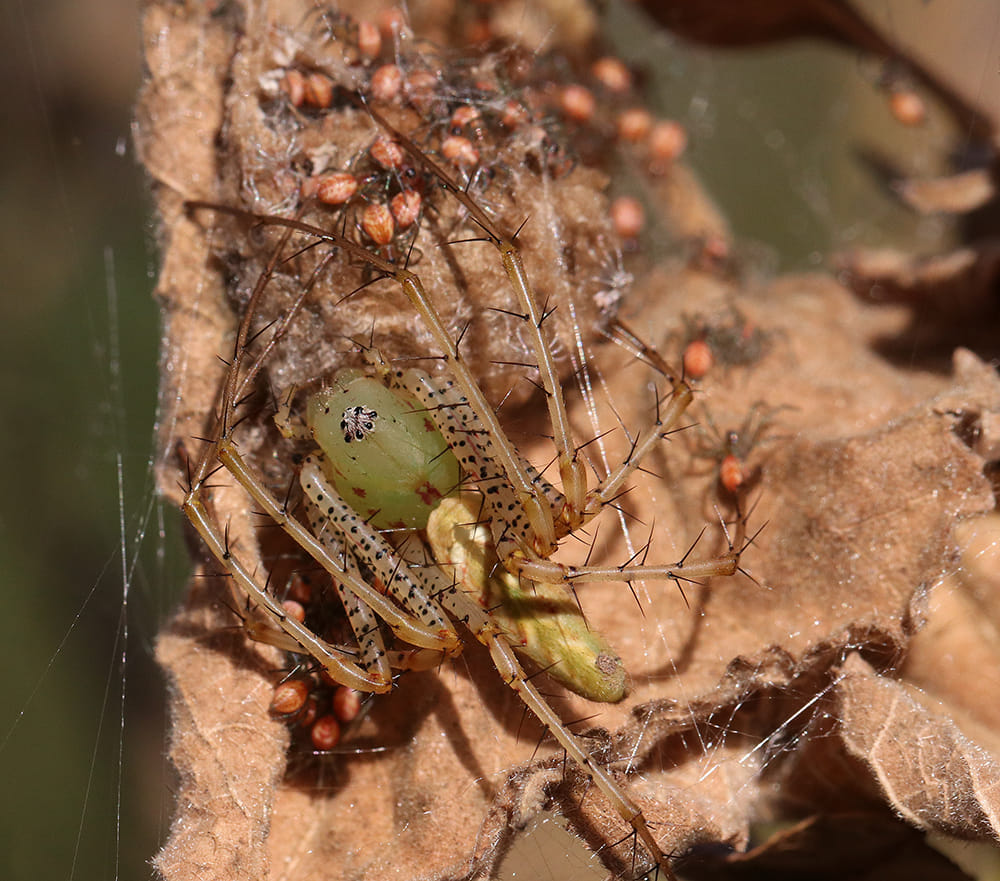
Green lynx spider mom with spiderlings in a nest of dried leaves at the tip of a seashore mallow plant in early December in the pollinator garden. Green lynx spiders make their nest near the tips of stems or branches, which is one of the reasons you don’t want to cut plants back in the fall. At the end of the year the lynx spider mom will die and the spiderlings will overwinter in the shelter of the plant canopy. Photo by Debbie Roos.

Newly hatched green lynx spiderlings in early December in the pollinator garden. Photo by Debbie Roos.

Egg sac of the Argiope writing spider on ironweed in the fall. Hundreds of spiderlings will hatch inside the egg sac in the fall but wait to emerge until the following spring – another reason to not remove plant stems in the fall. Photo by Debbie Roos.

Seedheads of ironweed and bee balm against a backdrop of pink muhly grass in the late fall. Photo by Debbie Roos.

Fall seedheads of Maryland golden aster against a sea of eastern silvery aster seedheads. Photo by Debbie Roos.

Towering seedpods of Carolina lupine against a backdrop of flowering splitbeard bluestem grass in the fall. Photo by Debbie Roos.
In North Carolina, we have over 560 species of native bees, most of them solitary. About 30% of these bees nest in cavities like hollow or pithy (soft) plant stems, and the majority of the other species nest in the ground. Other invertebrates like solitary wasps, stem-boring moths, spiders, and other beneficial insects may also nest in hollow stems.

This small carpenter bee (Ceratina sp.) is able to chew through the pithy center of plant stems to make a nest. Photo by Debbie Roos.
Native stem-nesting bees start emerging in the spring and commence collecting pollen and looking for nesting sites. Bees pack pollen into the stems and lay eggs, then the larvae hatch and consume the pollen and develop throughout the year. They hibernate during the winter and emerge the following spring. The stems will naturally decompose in the garden.
I wait until late winter/early spring (late February/March) to start cutting plants back. I aim to have at least some stems cut back by early March when our earliest emerging stem-nesting bees, the mason bees, start looking for nesting sites.

This orchard mason bee foraging on fernleaf phacelia is one of our earliest emerging stem-nesting bees in the spring. Photo by Debbie Roos.

Plants like this rattlesnake master are cut back in early spring to provide nesting habitat for native bees and wasps. This species has a nice hollow stem that attracts nesting bees. Having stems of different diameters provides potential nesting habitat for a diversity of bees. Photo by Debbie Roos.
I used to erect artificial bee hotels in my pollinator garden but never had adequate time to maintain them, preferring instead to spend my time gardening. If not maintained properly, bee hotels can harbor diseases and parasites. I find it much easier to provide nesting habitat through stem management, which naturally distributes nesting sites throughout the garden rather than concentrating them at high density such as in a bee block.
Resources for Additional Information
Pollinator Paradise Garden Website
Provide Nesting Habitat for Native Bees Through Plant Stems in Your Garden
Spring Chores in the Pollinator Garden
Favorite Snapshots from the Pollinator Paradise Garden
Nesting and Overwintering Habitat for Pollinators and Other Beneficial Insects – Xerces Society
Leave the Leaves: Winter Habitat Protection – Xerces Society
Leave the Leaves: These Invertebrates Depend on It – Xerces Society


